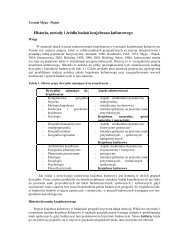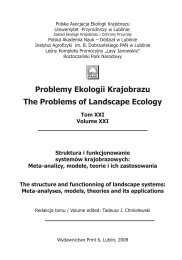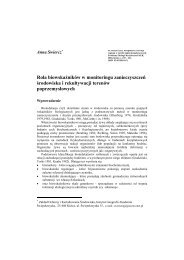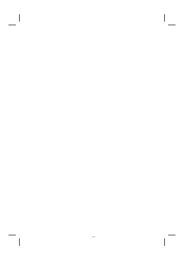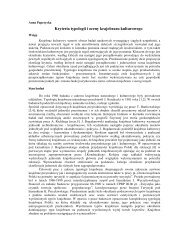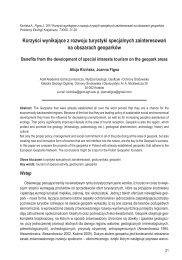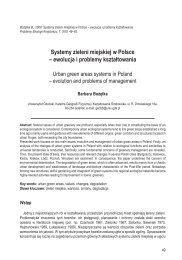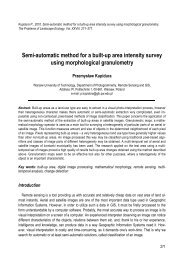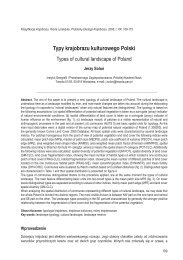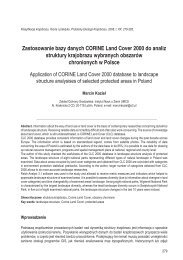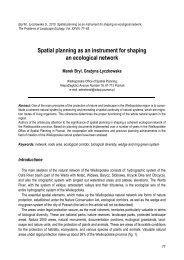Estimation of the area of sealed soil using GIS technology and ...
Estimation of the area of sealed soil using GIS technology and ...
Estimation of the area of sealed soil using GIS technology and ...
You also want an ePaper? Increase the reach of your titles
YUMPU automatically turns print PDFs into web optimized ePapers that Google loves.
Białousz S., Kupidura P.<br />
Table 2. The <strong>area</strong> <strong>of</strong> different built-up zones measured on <strong>the</strong> satellite image<br />
Class <strong>of</strong> built-up <strong>area</strong> Area <strong>of</strong> <strong>the</strong> class [km 2 ] Total <strong>sealed</strong> <strong>area</strong> [km 2 ]<br />
Very high density 6.19 5.94<br />
Very high density (industrial zones) 17.29 15.73<br />
High density (bordering buildings) 29.23 21.63<br />
High density (public domain) 2.86 2.15<br />
Medium density (blocks) 80.23 41.72<br />
Low density 63.13 16.61<br />
Very low density 48.16 9.63<br />
Summarizing, according to <strong>the</strong> presented methodology total <strong>sealed</strong> <strong>area</strong> in Warsaw is c.a. 113 km 2<br />
what gives 43% out <strong>of</strong> 247 km 2 <strong>of</strong> built-up <strong>area</strong> <strong>and</strong> 22% out <strong>of</strong> total <strong>area</strong> <strong>of</strong> Warsaw (518 km 2 ).<br />
Lomianki municipality pilot <strong>area</strong><br />
The same methodology has been applied in <strong>the</strong> second pilot <strong>area</strong> – Lomianki municipality. There were<br />
two differences in <strong>the</strong> process: different classes <strong>of</strong> built-up <strong>area</strong> have been determined <strong>and</strong> <strong>the</strong> satellite<br />
image <strong>of</strong> very high resolution have been used for a determination <strong>of</strong> percentage <strong>of</strong> <strong>sealed</strong> <strong>soil</strong> in <strong>the</strong>se<br />
built-up classes. Also, <strong>the</strong> use <strong>of</strong> multi-temporal set <strong>of</strong> images allowed to calculate L<strong>and</strong> Take indicator.<br />
The following built-up <strong>area</strong> classes have been determined:<br />
• residential,<br />
• industrial <strong>and</strong> commercial,<br />
• public domain,<br />
• recreational.<br />
As mentioned above, a percentage <strong>of</strong> <strong>sealed</strong> <strong>area</strong> in <strong>the</strong>se classes have been determined in a satellite<br />
Quickbird image. Table 3 presents a percentage measured for <strong>the</strong> samples <strong>of</strong> <strong>the</strong> determined built-up<br />
<strong>area</strong> classes.<br />
Table 3. The percentage <strong>of</strong> <strong>sealed</strong> <strong>soil</strong> in different built-up classes according to <strong>the</strong> samples measured on <strong>the</strong> satellite image<br />
Class <strong>of</strong> built-up <strong>area</strong><br />
Sealed <strong>area</strong> after satellite image<br />
[%]<br />
Residential 35<br />
Industrial <strong>and</strong> commercial 93<br />
Public domain 64<br />
Recreational 9<br />
The measurement <strong>of</strong> <strong>the</strong> <strong>area</strong> <strong>of</strong> different classes has been made <strong>using</strong> remote sensing data. Four aerial<br />
<strong>and</strong> satellite images <strong>of</strong> different dates <strong>of</strong> acquisition have been used:<br />
• aerial photo from 1977,<br />
• aerial photo from 1987,<br />
• aerial photo from 1997,<br />
• satellite Quickbird image from 2007.<br />
258



